Minimum and maximum distances between the most common sprinkler heads—and from heads to walls—receive careful attention in NFPA 13
A single fire sprinkler can cover an impressively large area, with modern fire codes allowing a single head to protect more than 200 square feet in some environments. But there’s more to sprinkler placement than square footage. Placing sprinklers too close to walls, to each other, or to obstacles can make a fire much more likely to spread. In part one of our series on maximum and minimum sprinkler distance, we take a close look at rules for standard spray sprinklers—such as:
- Why do we need rules regarding distances between fire sprinklers?
- What main factors determine sprinklers’ required distances?
- Pendent and upright fire sprinklers: what’s the maximum allowable distance between two heads?
- Sidewall fire sprinklers: what’s the maximum allowable distance between two heads?
- All sprinkler types: what’s the minimum allowable distance between two heads?
- All sprinkler types: what’s the minimum or maximum allowable distance from walls?
QRFS also invites you to browse our selection of commercial fire sprinklers, including standard spray models, from leading fire-safety manufacturers.
Concerns over late or failed activation create a need for fixed distances from sprinkler heads to walls (and each other)
The installer’s bible for commercial sprinklers is NFPA 13: Standard for the Installation of Sprinkler Systems. NFPA 13’s rules on distances ensure, first and foremost, that sprinklers spray when and where they’re supposed to spray.
In this article, we focus on rules for standard spray sprinklers—a widely-used sprinkler type that serves as the standard for sprinkler performance. The NFPA 13 Handbook explains that they are “proven to be effective for a broad range of hazards and applications by adjusting the water discharge density.”
Decades ago, when standard spray sprinklers were far and away the most common type, these rules might be all that a contractor needed to know. But the experts behind NFPA 13 have added new rules to accompany newer sprinkler types, charging today’s installers with keeping track of minimum distance and obstruction requirements for a variety of sprinklers.
Why do installers need these rules? In short, heat activates fire sprinklers. Consequently, each head belongs in a location that exposes its heat-sensitive parts to the layer of hot gases that build up when fires burn. As we’ve explained in our article on sidewall sprinklers, where walls meet walls—or walls meet ceilings—cooler pockets of air can remain locked in place, delaying activation. And because heat rises, a similar concern exists for sprinklers placed too far below the ceiling.

One other concern remains key to sprinkler distances: cold soldering. If one sprinkler discharges on another, the second sprinkler will cool. As a result, that sprinkler may not discharge on time—or at all. Proper spacing can prevent this unwanted problem from taking place.
Sprinkler distances vary with system types and sprinkler design
The maximum and minimum sprinkler distance between standard spray sprinklers—and from heads to walls—vary with two main factors:
- Sprinkler characteristics. The design and performance of fire sprinkler heads have a significant impact on distance and obstruction requirements. Chapters 10 through 15 of NFPA 13 (2019) provide these guidelines in detail.
- Sprinkler orientation. NFPA 13 has rules specific to pendent, upright, and sidewall heads in subsections throughout the chapters above.
Spacing requirements between sprinkler heads can also vary with the type of construction—that is, with the presence of combustible materials or fixed obstructions. In NFPA 13, the type of sprinkler system installed also plays a role in determining the maximum space between fire sprinklers. Sprinkler systems can be broken into two types:
- Systems designed with the pipe schedule method. Designers use the building’s hazards, water supply, and sprinkler placement density to determine appropriate pipe size for sprinklers on branch lines.
- Hydraulically designed sprinkler systems. Designers rely on mathematical analysis of pipes’ capacity to distribute water to fire sprinkler heads.
The sprinkler’s maximum distance from walls correlates with these spacing requirements. As the maximum spacing between sprinklers increases, so does the maximum allowable distance from walls.
NFPA 13 modifies these requirements for small rooms, curved surfaces, and angled walls. Further, installers may sometimes place specially equipped or specially designed sprinklers close together. One such exception is the in-rack sprinkler, used when ceiling-mounted sprinklers can’t effectively protect items stored on racks. NFPA 13 also allows close spacing for heads equipped with baffles—bowl or disc-shaped accessories that keep one sprinkler’s spray from prematurely cooling another head.

Maximum spaces between standard upright and pendent sprinklers vary with a room’s hazards
For standard upright and pendent sprinklers, NFPA 13 establishes a maximum sprinkler-to-sprinkler distance using five tables. Tables 10.2.4.2.1(a) through 10.2.4.2.1(d) set spacing and protection area requirements for four hazard types:
- Light Hazard (10-15 ft). Excluding heads in combustible concealed spaces, all sprinklers in this category have 15 feet (4.6 meters) of maximum allowable spacing between them.
- Ordinary Hazard (15 ft). All sprinklers in these environments have a 15-foot (4.6-meter) maximum.
- Extra Hazard (12-15 ft). The rules vary by system type. Pipe-schedule systems and hydraulically calculated systems with a density at or over 0.25 gallons per minute per square foot have a 12-foot (3.7 meters) maximum distance between sprinklers. Hydraulically calculated systems with less density have the standard 15-foot (4.6-meter) maximum.
- High-Piled Storage (12-15 ft). Hydraulically calculated systems with a density at or over 0.25 gallons per minute per square foot have a 12-foot (3.7 meters) maximum. Hydraulically calculated systems with densities under 0.25 have the standard 15-foot (4.6-meter) maximum.
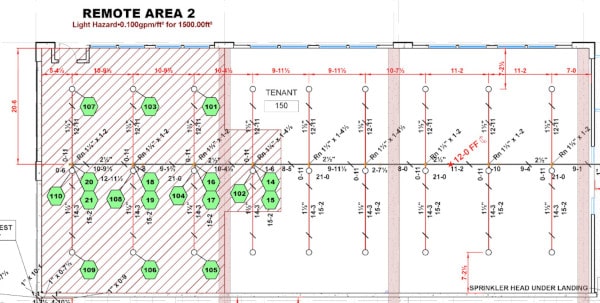
Two exceptions deserve a mention:
- Sprinklers in some light-hazard, combustible concealed spaces (see 10.2.6.1.4) have especially detailed requirements. Maximum spacing varies from 10 to 15 feet.
- Where extra-hazard occupancies and high-piled storage feature bays made from solid structural members, spacing may increase to 12.5 feet. However, this doesn’t apply to calculated systems with densities under 0.25 gallons per minute per square foot.
Hazards and concerns over cold soldering determine the maximum spacing between standard spray sidewall sprinkler heads
Sidewall sprinkler heads typically mount on a wall. When it’d be hard to use pipes in the ceiling, or when overhead sprinklers simply wouldn’t look good, sidewall sprinklers provide designers an alternative. While the distance between sprinklers is a fairly simple topic for pendent and upright types, NFPA 13 has detailed rules for standard sidewall fire sprinkler heads.
First off: installers can’t measure these distances from the inside edges. Nor can they always measure for the shortest possible length.
From the 2019 edition of NFPA 13
10.3.4.1.1 The maximum distance permitted between sidewall spray sprinklers shall be based on the centerline distance between sprinklers on the branch line.
10.3.4.1.2 The maximum distance between sidewall spray sprinklers or to a wall shall be measured along the slope of the ceiling.
In section 10.3.4, NFPA 13 clarifies that the maximum distance also varies with the hazards involved:
- Light-hazard areas allow a maximum distance of 14 feet (4.3 meters).
- Ordinary-hazard areas permit a distance of only 10 feet (3 meters).
- Sidewall heads protecting spaces below overhead doors have maximum distances for light-hazard areas, even when installed in ordinary-hazard environments.
To stop cold soldering, sidewall sprinklers placed on opposing or adjacent walls must not be within the maximum protection area of another sprinkler. Additionally, installers can’t place these sprinklers back-to-back without a lintel (a beam typically placed over a door or window) or soffit (a lowered section of a ceiling) between them. This can stop a sprinkler from spraying needlessly—or prevent cold soldering of one sidewall head by another. However, that lintel or soffit can’t exceed 16 inches in width unless it’s protected by a pendent head.
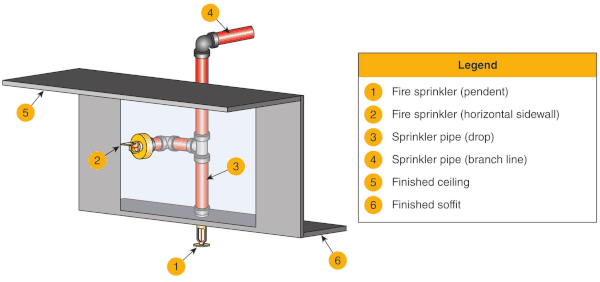
Minimum distance: With few exceptions, NFPA 13 requires at least six feet between all standard spray fire sprinklers
While maximum distances between sprinklers vary with the room’s hazards and fire sprinkler types, the minimum sprinkler distance from head to sprinkler head changes with only two factors:
- Are sprinklers (properly) equipped with baffles?
- Are they in-rack sprinkler heads?
NFPA 13’s rules for sidewall heads closely resemble those for pendent and upright types. Those guidelines, found in sections 10.2.5.4 (pendent and upright) and 10.3.4.4 (sidewall), require 6 feet of clearance between heads. That minimum distance is measured from the center of each sprinkler head (or, “on center”).
Baffles allow for reduced spacing between heads when they:
- Protect the actuating elements (heat-sensitive bulbs and links)
- Consist of “solid and rigid material that will stay in place before and during sprinkler operation”
- Are no longer than 8 inches and no higher than 6 inches
- Have tops that extend from 2 to 3 inches above upright and sidewall deflectors
- Have bottoms that “extend downward to a level at least even with” pendent and sidewall deflectors
NFPA 13 makes one final exception for in-rack sprinklers. Because they’re designed to work even when closely spaced, in-rack sprinklers may be placed closer than six feet together (10.2.5.4.3).
All standard spray sprinklers have four-inch minimum spacing from walls and maximums that vary with room shape and size
All standard sprinkler heads—pendent, upright, and sidewall—have the same minimum sprinkler distance from walls: four inches. For sidewall heads, that’s the distance from an end wall (10.3.4.3.1). Pendent and upright sprinkler heads keep this minimum distance from all walls (10.2.5.3). In doing so, these heads stay away from sources of cool air that might delay their activation or surfaces that could block the intended spray pattern.
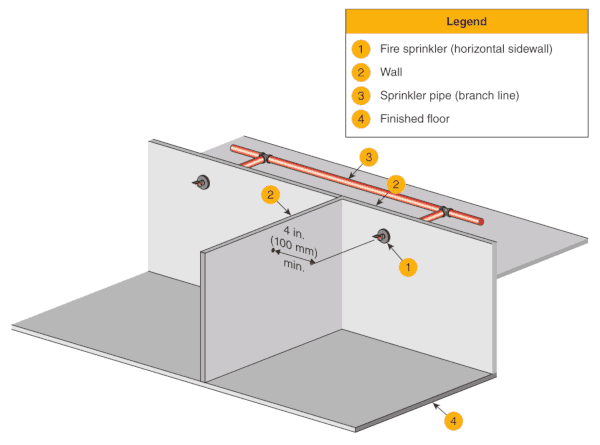
However, NFPA 13 has much more to say about the maximum distances between fire sprinklers and walls. For all head types, the maximum distance between heads and walls is half of the maximum distance permitted between two sprinkler heads (the latter detailed in the sections above). For example, an upright sprinkler in an ordinary hazard environment can be as far as 15 feet from an adjacent head. That same head can be up to half that distance—as far as 7.5 feet—from a wall.
For pendent and upright heads, NFPA 13 has more detailed requirements on distances from walls, including:
Exceptions for irregular or angled walls (10.2.5.2.2).
When two walls meet at a narrow angle, a sprinkler placed just a few feet away from those walls may wind up being a considerable distance away from the corner space it’s supposed to protect. This is just a quirk of design, and NFPA 13 makes allowances for these odd-shaped rooms. It prescribes a longer maximum distance between the head and the corner where walls meet at odd angles.
Thus, whereas the distance from heads to the wall normally may be no further than 0.5 times the maximum allowable distance from sprinkler head to sprinkler head (0.5 x the maximum distance of 15’ between sprinklers = 7.5’), if there is a sharp angle in a deep corner, this maximum to the corner jumps to 0.75 (.75 x 15’ = 11.5’), as shown in the image below:
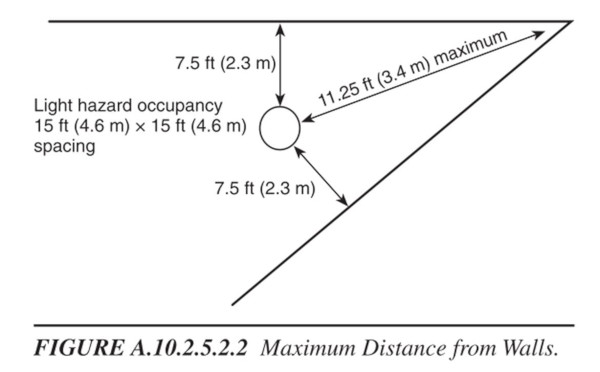
Exceptions for small rooms (10.2.5.2.3).
Light-hazard compartments under 800 square feet may follow different rules. When these small rooms have unobstructed construction, sprinklers’ maximum distance from walls becomes 9 feet. For more details, see the section referenced above in NFPA 13.
To be continued: NFPA 13’s rules on sprinkler head distance
This concludes part one of our look at NFPA 13’s rules regarding maximum and minimum sprinkler distances from walls and between heads. We’ve only scratched the surface of the standard’s extensive guidelines for safe and effective sprinkler placement—so stay tuned for more.
If you’re looking for versatile standard spray sprinkler heads, take a look at QRFS’s selection of UL-listed and FM-approved heads. Our stock of Tyco, Senju, Victaulic, and Viking heads features a wide range of finishes, response types, and temperatures for a broad spectrum of buildings and applications.
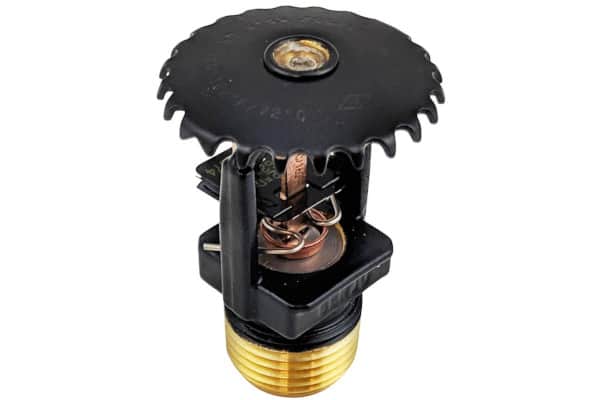
View our full inventory of commercial fire sprinklers.
Questions? Call us at +1 (888) 361-6662 or email support@qrfs.com.
This blog was originally posted at blog.qrfs.com. Visit us at Facebook.com/QuickResponseFireSupply or on Twitter @QuickResponseFS.


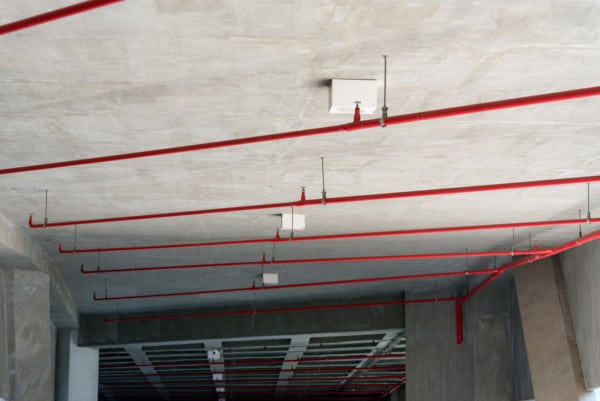

These blog posts are exceptionally well written and easily the most comprehensive source online (excluding NFPA 13 of course)
I supervise an 8 unit apartment building in RI. I have an unused basement which I am planning to install 2 washers and and 2 dryers coin operated and there is
additional space on other side which I was thinking of putting in 8 / 8 by 6 storage areas for the tenants. I also want to install fire sprinklers for the area as
it will reduce my insurance costs quite a bit. I am a licensed plumber and was actually a licensed sprinkler fitter 40 years ago. Would I be able to install a 40 foot section
of one inch copper piping with an upright sprinkler head at the center of each area with the necessary backflow devices and shutoffs as needed . Would this installation
adhere to the local codes and ordinances for the state of RI. I know that the fire codes have become very strict since we had a terrible fire in a town in RI app 10 years ago.
David — Thanks for reaching out. For code questions like this, we recommend submitting your question through QRFS Ask A Pro. Click the link to submit your question with some information about your building or system, and a fire protection professional will provide a detailed answer based on standards and codes. Our pros include AHJs, contractors, engineers, and code experts with 150+ years of combined experience!
Fire protection for under veranda areas , to prevent embers starting a major fire
Country NSW .
Planning sprinkler pattern 15 feet apart will this give me 7 ft 6 in spray on the end sprinkler.
System will be connected to mains water .
Allen — Do you have a question? If so, for questions like this, we recommend submitting your question through QRFS Ask A Pro. Click the link to submit your question with some information about your building or system, and a fire protection professional will provide a detailed answer based on standards and codes. Our pros include AHJs, contractors, engineers, and code experts with 150+ years of combined experience!
Can we allow a tolerance of 300mm to 400mm clearance between sprinkler heads and parking building slab soffit?
This is an open space parking area typical for 9 floors. Appreciate your earliest response. Thanks.
Marlo – For code and standards interpretation questions like this, you can try our Ask a Fire Pro service. Click the link to submit your question with some information about your building, and a fire protection professional will provide an answer based on standards and codes. Our pros include AHJs, contractors, engineers, and code experts with 150+ years of combined experience!
THIS IS A QUESTION — I’m designing a home plan with the intent of a sprinkler system throughout (2-story). The home is in a rural area with an isolated well & pressure supply. I’m not finding an answer about a soffit arrangement containing the main line and its sprinklers co-existing w/can lights in a common area. Also, the return ducts of the HVAC utilize the soffit to openly draw air back to a main trunk in a sidewall (Soffit is totally surrounded w/drywall on all 4 sides). The intent is to keep these items in a controlled air space to guard the pipes from the ‘cold’ (and looking ugly) along w/separating the light fixtures from any ceiling insulation. Obviously, the lights aim downward & sprinkler heads deliver sideways. Any thought about this being improper or possible?
John — For system application (and installation standard) questions like this, you can try our Ask a Fire Pro service. Click the link to submit your question with some information about your building, and a fire protection professional will provide an answer based on best practices, standards, and codes. Our pros include AHJs, contractors, engineers, and code experts with 150+ years of combined experience!
In a factory where several buildings include a separate workshop, a separate office building, and a separate guardhouse, and each of them has different areas, is it necessary to install sprinklers for all these buildings? Or should each one be examined as an independent building and a decision should be made on whether or not to install sprinkler? In fact, for a complex with separate buildings, one of which needs a sprinkler, should sprinklers be installed for all of them or not?
Mojtaba — For system and code questions like this, you can try our Ask a Fire Pro service. Click the link to submit your question with some information about your building and system, and a fire protection professional will provide an answer based on best practices, standards, and codes. Our pros include AHJs, contractors, engineers, and code experts with 150+ years of combined experience!
I’m simply looking to mount a TV on the bedroom wall of my apartment. How close to the sprinkler head can I get before I find myself in violation? Will the heat generated by the tv alone set the sprinkler off? Thanks in advance.
Daniel — the heat from a TV should not set a sprinkler off; for example, most sprinklers have about a 155F activation temperature. Regarding the distance, there are various rules governing the required distances based on sprinkler type, hazard environment, etc., such as “Table 10.3.6.1.3(a) Positioning of Sprinklers to Avoid Obstructions to Discharge (Standard Spray Sidewall)” in NFPA 13. We advise you to contact a qualified fire sprinkler contractor to determine the appropriate distance.
I have a client with a 2 inch copper main and a single story warehouse, clear span with wooden roof trusses.
I would like to see with the right Upright sprinkler heads at 13 feet on center for 24 sprinkler heads with the right high efficiency or low flow factor could work with a 2 inch copper main at 100 psi?
The sprinkler field is 86 x 39 feet and the height of the structure is 16 to the bottom of the roof trusses. We would have the upright sprinkler heads 18 inches higher than the top of the roof joists.
Can you provide spec sheets on the recommended sprinkler heads.
I can go to a larger main line, just expensive to do. It looks like it is possible.
Material stored is wine and liquor. Very low occupancy, industrial zoning, no general public access. Warehouse storage and fork lift only. I am happy to take a call if you have any questions.
Klas — Unfortunately, these are fairly complex, situation-specific design questions on the fairly complex topic of sprinkler spacing and placement, and thus not best answered sight unseen in this venue. However, QRFS does have a paid Ask a Fire Pro service that is currently re-tooling and will be released soon. It provides the opportunity for a fire pro to ask for more details and answer questions such as these. Time permitting, you can check back in a couple of weeks or so—otherwise, you should contact a local fire protection pro, ideally a registered design professional, to assess your needs in-depth. Thanks!
If I have a 14×14 perfectly spaced heads in a square can I place a sprinkler head dead center of the square and would it be considered ordinary hazard
Geoff — occupancy hazard levels aren’t determined by the sprinklers; they determined the types of sprinklers and are determined by the (design) area the sprinklers protect. You should consult a qualified design professional or other fire protection contractor to determine the hazard level. Thanks for reading!
We are building a full 4 sided network cage for one of our clients. they would like to install a chain link fence ceiling to the top of the cage. How far do we have to be from the ceiling fire sprinkler pendant to the top of the cage? Is there regulations that states this for this situation?
Jun — What you are generally describing falls under clearance and obstruction rules. These can be complex, but without evaluating your specific situation and specs, the main rule is that objects should have at least 18″ of vertical clearance from sprinklers. Otherwise, the rules can get detailed, an example of which is outlined in this blog. We advise that you run the client’s intended plans by a fire protection designer.
what is the minimum distance between the fire sprinklers and vessel/equipment?
Luis — Generally speaking, a standard distance between sprinklers and objects is at least 18″, but obstruction rules can be complicated and object-specific, and we’re not sure what you mean by vessel. We suggest you contact a qualified local fire protection pro to assess your situation. Otherwise, you can try our Ask a Fire Pro service for an informal interpretation of the rules in NFPA 13.
I would like to instal ceiling fans in my new apartment, one in living room and one each in the 2 bedrooms. The 2 bedrooms have a fire sprinkler in the centre of each room. Does the ceiling fan need to be away from the centre and if so how far away from the sprinklers ? The 2 Living room sprinklers are placed, one near the kitchen end and one towards the external wall at the other end. Can I assume that the ceiling fan could be placed in the centre of the room, nowhere near either sprinkler ? In the case of the two bedrooms, can the ceiling fans be placed off centre, not in line with the sprinklers and hanging down 450mm below the sprinkler line ? Alternately, as the ceiling fans will be hanging down from the ceiling by at least 450mm, their distance would not be a problem.
Barrie — Yes, the ceiling fans need to be well clear of the sprinkler. We cannot provide specific advice on clearance in this format. Your best bet is to call your local AHJ (e.g., fire marshal) or a fire sprinkler pro, and they can provide more explicit guidance. Thanks for reading.
what’s the maximum distance b/w soffit to concealed sprinkler or upright sprinkler
Ram — Apologies, but we’re not clear on what you are asking. Between a soffit and a concealed or sprinkler in what arrangement? First, the majority of rules referencing soffits in chapter 10 apply to sidewalls. And we’re unsure what you mean by “between a soffit to the sprinklers.” (E.g., deflector distance to collect heat? Placement of these sprinklers relative to a soffit in what position, to determine whether the soffit is an obstruction? Etc.)
As essentially all of your answers are “Ask a Pro,” this page doesn’t provide a lot of useful information. It might be better to just clarify that responding to specific questions will generally require a professional assesseement.
Martin — We answer numerous questions in this forum when the questions are clear, relatively straightforward, and the answers are both clear and something that can be provided with reasonable effort and knowledge. We also provide answers to QRFS-product-specific questions or escalate them to customer service. Our aim is to help people understand these topics and their systems!
However, questions that relate to unique system design approaches, involve complex code interpretations, and/or require more specific information about a specific system and building are not answered in this forum. Here are the challenges:
1. We believe it would be irresponsible to provide specific system-design guidance or, in many cases, subjective interpretations of codes and standards, particularly without knowing enough details about a system and building.
2. While the blogs on this site are contributed to and/or fact-checked by fire protection professionals, certain accurate answers in this forum would require system designers (PEs or architects) or authorities having jurisdiction (AHJs) to answer specific questions—ones where the answers would normally require consulting a local professional to assess a unique situation. Such an interaction often requires detailed, two-way information exchanges. Unfortunately, that solution is prohibitive in this forum for several reasons.
3. We frequently recommend that individuals consult a local professional or AHJ, as in several comments under this post. The Ask a Fire Pro service is simply another option that QRFS offers primarily as a service where we escalate questions to a higher information-gathering and knowledge level—not due to a profit incentive.
Thanks for reading and commenting!